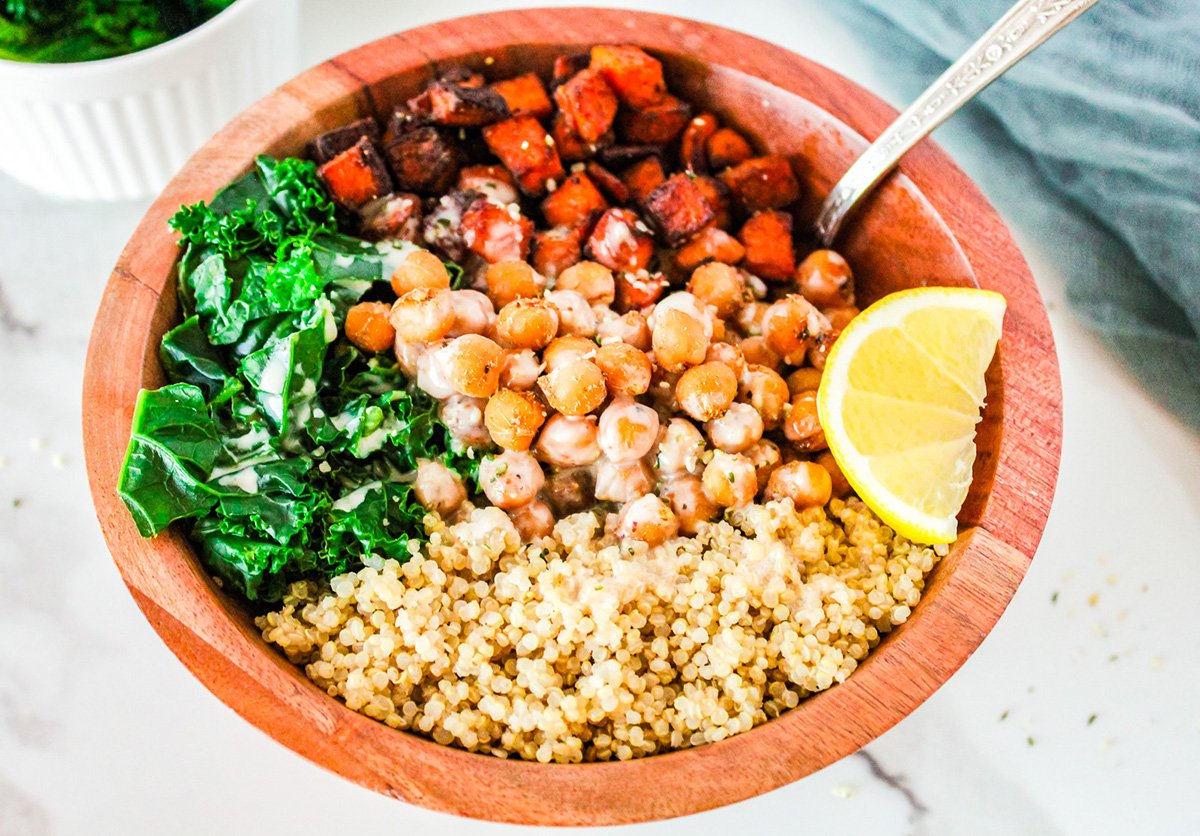Unleash your inner culinary artist with this guide to crafting the perfect egg-free Buddha bowl! Imagine a vibrant tapestry of textures and flavors—a symphony of crunchy roasted vegetables, tender grains, and protein-packed delights, all artfully arranged in a visually stunning masterpiece. Forget bland and boring; we’re diving deep into the world of delicious and nutritious egg-free Buddha bowls, exploring diverse base options, protein sources, and flavor combinations that will tantalize your taste buds and leave you feeling energized and satisfied.
From the satisfying chew of quinoa to the nutty heartiness of farro, we’ll explore the best bases for your creation. We’ll then journey through a world of protein, showcasing the versatility of tofu, chickpeas, and lentils, each offering a unique textural and flavor profile. The vibrant heart of your bowl will be built with a carefully curated selection of seasonal vegetables, expertly prepared to maximize their natural goodness. Finally, we’ll crown your creation with a selection of delectable dressings—from creamy tahini to zesty ginger-soy—each carefully balanced to enhance the overall experience. Prepare to be inspired!
Vegetable Selection and Preparation
Crafting a vibrant and nutritious egg-free Buddha bowl hinges on a thoughtful selection of vegetables, their preparation maximizing both flavor and visual appeal. A diverse range of colors and textures contributes not only to aesthetic beauty but also to a wider spectrum of vitamins, minerals, and antioxidants.
The optimal cooking method for each vegetable varies, impacting its final texture and taste. Roasting brings out natural sweetness and creates a satisfying caramelization; steaming preserves nutrients and a crisp-tender bite; while sautéing offers a quick way to achieve tender-crisp results with enhanced flavor from herbs and spices. Consider seasonal availability for the freshest and most flavorful produce.
Seasonal Vegetable Combinations and Cooking Methods
A perfect egg-free Buddha bowl thrives on a dynamic interplay of colors and textures. Imagine a bowl brimming with the deep orange of roasted sweet potatoes, the vibrant green of steamed broccoli florets, the fiery red of sautéed bell peppers, and the earthy purple of roasted red onions. Seasonal variations offer endless possibilities. For instance, during summer months, you might incorporate juicy cherry tomatoes and crisp cucumbers, while autumn might feature butternut squash and Brussels sprouts.
- Roasted Sweet Potatoes and Red Onions: Dice sweet potatoes and red onions into roughly one-inch pieces. Toss with olive oil, salt, pepper, and a touch of paprika. Roast at 400°F (200°C) for 20-25 minutes, or until tender and slightly caramelized. The resulting sweetness complements other vegetables beautifully, providing a satisfying base for the bowl.
- Steamed Broccoli: Cut broccoli into florets. Steam for 5-7 minutes, until tender-crisp but still vibrant green. Steaming preserves the broccoli’s nutrients and bright color, providing a refreshing contrast to the roasted vegetables.
- Sautéed Bell Peppers: Slice bell peppers into strips. Sauté in olive oil with a pinch of garlic powder and a sprinkle of red pepper flakes for 5-7 minutes, until tender-crisp and slightly charred. The sautéing method enhances the peppers’ natural sweetness and adds a delightful smoky flavor.
Vegetable Preparation Steps
Proper preparation ensures optimal flavor and texture in your Buddha bowl. Follow these steps for consistent results.
- Wash all vegetables thoroughly under cold running water. This removes any dirt or pesticides and is crucial for food safety.
- Prepare the vegetables according to the chosen cooking method. This may involve chopping, dicing, slicing, or otherwise preparing them for cooking.
- Cook the vegetables according to the instructions provided for each method (roasting, steaming, or sautéing). Ensure even cooking and avoid overcooking, as this can lead to mushy vegetables.
- Once cooked, allow the vegetables to cool slightly before adding them to your Buddha bowl. This prevents the bowl from becoming too hot to handle.
- Arrange the cooked vegetables artfully in your bowl, creating a visually appealing presentation. Consider layering or arranging the vegetables by color and texture for maximum impact.
Flavorful Dressings and Sauces

The perfect Buddha bowl isn’t complete without a vibrant and flavorful dressing to tie all the elements together. The right sauce can elevate the simple ingredients into a symphony of textures and tastes, adding a crucial layer of complexity and satisfaction. Below, we explore three distinct dressings, each offering a unique flavor profile to complement your carefully chosen vegetables. Remember, the beauty of a Buddha bowl lies in its adaptability, so feel free to experiment and adjust these recipes to your personal preferences.
Tahini Dressing
This creamy and subtly sweet dressing provides a rich base for your Buddha bowl. The tahini’s nutty flavor pairs beautifully with the earthiness of roasted vegetables and the freshness of raw ingredients.
- Ingredients: 1/4 cup tahini, 2 tablespoons lemon juice, 1 tablespoon water, 1 clove garlic (minced), 1/2 teaspoon ground cumin, salt and pepper to taste.
- Instructions: Whisk together all ingredients in a small bowl until smooth and creamy. Add more water, a teaspoon at a time, if needed to reach your desired consistency. A touch of maple syrup can be added for extra sweetness, if desired.
To balance flavors, the tartness of the lemon juice counteracts the richness of the tahini, while the cumin adds a warm, earthy note. Adjusting the amount of water controls the thickness; for a thicker dressing, use less water; for a thinner dressing, add more. A sprinkle of chopped fresh parsley or cilantro brightens the flavor and adds visual appeal. Imagine the creamy, ivory-colored dressing clinging to the vibrant vegetables, the flecks of green parsley providing a delightful contrast.
Peanut Dressing
This nutty and savory dressing offers a more robust flavor profile, ideal for bowls featuring strong-flavored vegetables like roasted broccoli or sweet potatoes. The peanut butter provides a satisfying creaminess, while the soy sauce adds a salty depth.
- Ingredients: 1/4 cup peanut butter (smooth or crunchy), 2 tablespoons soy sauce (or tamari for gluten-free), 1 tablespoon rice vinegar, 1 tablespoon water, 1 teaspoon sesame oil, 1/2 teaspoon sriracha (or to taste), 1 tablespoon maple syrup.
- Instructions: Combine all ingredients in a small bowl and whisk until smooth. The sriracha adds a subtle kick; adjust the amount to your preference for heat. For a thinner dressing, add more water, a teaspoon at a time.
The balance of sweet, salty, and savory is achieved through the interplay of the peanut butter’s nuttiness, the soy sauce’s saltiness, the rice vinegar’s tang, and the maple syrup’s sweetness. The sesame oil adds a subtle nutty aroma and depth of flavor. A garnish of chopped peanuts adds texture and visual interest; envision the rich, reddish-brown dressing coating the vegetables, speckled with crunchy peanuts.
Ginger-Soy Dressing
This bright and zesty dressing is a perfect complement to lighter vegetables and offers a refreshing counterpoint to richer ingredients. The ginger’s pungent aroma and subtle heat are balanced by the soy sauce’s saltiness and the citrus’s acidity.
- Ingredients: 2 tablespoons soy sauce (or tamari), 1 tablespoon rice vinegar, 1 tablespoon fresh ginger (grated), 1 tablespoon lime juice, 1 teaspoon sesame oil, 1/2 teaspoon honey (or maple syrup), pinch of red pepper flakes (optional).
- Instructions: Whisk all ingredients together in a small bowl until well combined. The red pepper flakes add a subtle warmth; omit if you prefer a milder dressing. Adjust the amount of honey or maple syrup to control the sweetness.
The ginger provides a vibrant, spicy note that is balanced by the tartness of the lime juice and the saltiness of the soy sauce. The sesame oil contributes a subtle nutty undertone. A few finely chopped scallions add a fresh, oniony flavor and a pop of color; picture the translucent, amber-colored dressing, glistening on the vegetables, with vibrant green scallions scattered throughout.
Creating the perfect egg-free Buddha bowl is more than just assembling ingredients; it’s an art form. By carefully selecting your base, protein, vegetables, and dressing, you can craft a visually stunning and incredibly flavorful meal that’s as nutritious as it is delicious. This guide has armed you with the knowledge and inspiration to embark on your own culinary adventures, experimenting with different combinations to discover your signature egg-free Buddha bowl masterpiece. So, gather your ingredients, unleash your creativity, and prepare to be amazed by the vibrant and satisfying results!
User Queries
Can I make this bowl ahead of time?
Yes! Prepare the components separately and store them in airtight containers in the refrigerator. Assemble just before serving to maintain optimal freshness and texture.
What if I don’t have all the suggested vegetables?
Feel free to substitute with your favorite vegetables! The key is to aim for a variety of colors, textures, and flavors.
Can I use different grains besides quinoa, brown rice, and farro?
Absolutely! Other grains like barley, freekeh, or even couscous can be delicious bases for your Buddha bowl.
How can I make the dressings thicker or thinner?
For thicker dressings, add more tahini or nut butter. For thinner dressings, add more water or lemon juice.


